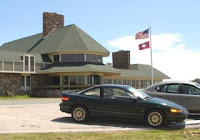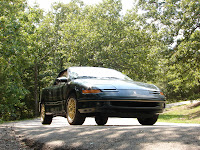There will never be another racetrack like Nurburgring as raced before and after World War II. The 1967 video doesn't include footage of the start-finish line and the old racing pits without even a hint of a safety barrier until the very end. At well over a 100 mph in small club racers and far beyond 150 miles an hour for grand prix cars, the wide combined space between the stadium seating to the left and the unprotected pits on the right quickly narrowed to a funnel while your right foot is still trying to push the accelerator pedal through the floor. Then a bright flash back into the sunlight while the exhaust still echoes off the walls as the road fades left and then with a smooth pressure on the steering wheel the car tilts into the long right hand banked 180 turn.
Handwritten notes on my 1 DM map of the track indicate the 180 was "straightforward" (meaning there were no surprises). It was the calm before the storm. The 180 loop is followed by a quick dash behind the racing pits and then over the first of many bridges, a sharp left bend and down through the dark, dense forest. It was a tremendously thrilling way to start another 22.8 kilometer lap around the Nordschleife, the long northern loop. I think my blood boiled as we - the car and its novice driver - descended into what were the longest laps in my brief racing career.
The revised northern loop used in current video no longer includes the original track portion past the stadium. The pits and area near the start-finish line have been extensively enhanced for the shorter Formula 1 track used for the present German Grand Prix series that alternates with Hockenheim.
Originally there was a link in the Times article also connected to a video of the 2008's production car record lap of 7 minutes 26.4 seconds set in the Corvette ZR1 driven by Jim Mero. That record was eclipsed in June 2011 when a 2012 Corvette ZR1 recorded an even faster lap of 7 minutes 19.6 seconds. The 2011 video is shown below. Nevertheless, the Corvette's impressive speeds and G-loadings are still impressive and fun to watch.
The June 9, 2011 record lap video below starts over the first bridge just about where I left off in my description of the old track several paragraphs above. You can also expand the newer video to full screen to get the full effect of a V8 engine at racing speed. You can also catch a few of the typical bobbles that happen on almost any Nurburgring lap. Keep an eye on the telemetry being recorded. The time? Seven minutes, 19.6 seconds; top speed, 183 mph; and in a production car that could be driven on the street!
You can easily contrast the speeds between the 1967 formula car video and the speeds recorded in the 2008 and 2011 videos. I recall the 1967 grand prix cars of the period were running lap times of about eight to eight and a half minutes at Nurburgring.
Of course any such records are meant to be broken. The 2008 Corvette record didn't last long. On August 28, 2008, a 2009 Dodge Viper ACR laid claim to the fastest production car record at Nurburgring completing a similar lap at 7 minutes, 22 seconds. Motor Trend has the video (which includes a short embedded commercial). Unfortunately, the Viper video lacks the telemetry and track location graphic included in the Corvette video to compare cornering and top speeds in different sections of the track. I suspect the differences in speed and g-loading might offer an interesting comparison. YouTube has a number of record runs by Nissan and others. Its a corporate version of "King of the Hill."
Development of telemetry and communications now available to today's professional racing teams are simply amazing. We didn't even think about in-car radios in the sixties or later when club racing with SCCA. Someone recorded the time for each lap with paper and pencil. The standard means of communicating lap times to the driver was often a cheap blackboard and chalk. Professional teams splurged on pit boards with interchangeable numbers and abbreviations. These boards were supplemented by informal signals which might include the team manager standing near a hay bale that sometimes separated the pits and the racing surface shaking a hammer or some other cryptic signal. Drivers sometimes signaled back with either prearranged hand signals of which several were sometimes less polite.
One of the secrets of Nurburgring (and Road Atlanta) in a small car was learning when and where you could keep your foot on the gas all the way down the hills (and where that's not a good idea). A slightly "improved" NSU Wankel Spyder with its single rotor engine got over 120 mph and maybe even 125+ on the downhills, but it was still fast enough to momentarily get the wheels slightly airborne in a couple of places where the track feels like it "falls away" as you crest the hill. The car would also feel very light topping some of the other hills and bumps. I never felt like I put in a "perfect lap" at the Ring. My fastest lap at Nurburgring during a club event was in the low 12's - that's 12 minutes and more than a few seconds. Thus my speeds were much closer to the speeds exhibited by the 1967 camera car. Once you've seen the two videos, you'll know why 12+ minutes didn't seem like such a bad lap time for a tiny 998cc NSU Spyder in almost stock trim.
I'm told very few foreigners ever really memorized the Nurburgring, but Lord knows I tried and studied films, diagrams and maps and even walked to sections of the track during other races when time permitted to observe other drivers on a particular turn. Years later, I tried to do the same at all the SCCA tracks too. NSU Spyders were competitive in the under one- liter GT class with Fiat Abarths, early Honda 2-seaters, and the factory NSU Spyders could out-run the fully prepared Sebring A-H Sprites. I was not embarrassed by my lap times at Hockenheim and Nurburgring given my really "amateur status." Heck, I could barely speak the language, but we always did the best we could both in terms of preparation and attitude. Nurburgring and Hockenheim proved to be good training for my later amateur racing adventures with the Central FloridaRegion, SCCA in the late seventies and early eighties.
By the way, you never see a full picture of the camera car in the first 1967 video, but the front suspension and narrow tires easily identify it as one of the original Formula Vee's that were quite popular in German club racing in the 1960's. The German auto club sponsored races had large fields of Formula Vee's (plenty of cheap Volkswagen spare parts available) and fiberglass was easy to patch. Early Formula Vee racing was always exciting to watch with a dozen competitive cars going wheel to wheel for the lead most of the race.
If racing is in your blood, I hope you enjoyed the video comparisons of the original and the present Nurburgring as much as I did when I found them. But I really cherish the experience of driving on the full Nurburgring track as it was originally intended for racing. I will always appreciate the hospitality of the Mannheim - Heidelberg Sports Touring Club members who helped me with their encouragement and patience with my limited German language and driving skills.
It was an experience of a lifetime. These days it's better to drive carefully, leave a few minutes earlier and reduce our highway speeds to save gas. Driving flat out at the original Nurburgring while young and foolish was fun while it lasted!...\B)
Back to Top of this BRT page.
Return to main Web Workshop Home Page
Updated: 11/29/11 (during transfer to new website)












